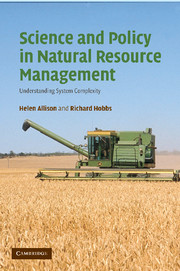Book contents
- Frontmatter
- Contents
- List of illustrations
- List of tables
- Foreword
- Preface
- Acknowledgements
- List of abbreviations
- 1 Introduction
- 2 Historical and policy context
- 3 Natural resource degradation: a resistant problem of the twentieth century
- 4 The epistemology of natural resource management of the twentieth century
- 5 A contemporary epistemology and framework for natural resource management of the twenty-first century
- 6 Model conceptualisation of the Western Australian agricultural region. Part 1: resilience analysis
- 7 Model conceptualisation of the Western Australian agricultural region. Part 2: system dynamics
- 8 Synthesis
- Epilogue
- Glossary
- References
- Index
2 - Historical and policy context
Published online by Cambridge University Press: 01 March 2010
- Frontmatter
- Contents
- List of illustrations
- List of tables
- Foreword
- Preface
- Acknowledgements
- List of abbreviations
- 1 Introduction
- 2 Historical and policy context
- 3 Natural resource degradation: a resistant problem of the twentieth century
- 4 The epistemology of natural resource management of the twentieth century
- 5 A contemporary epistemology and framework for natural resource management of the twenty-first century
- 6 Model conceptualisation of the Western Australian agricultural region. Part 1: resilience analysis
- 7 Model conceptualisation of the Western Australian agricultural region. Part 2: system dynamics
- 8 Synthesis
- Epilogue
- Glossary
- References
- Index
Summary
Rather than float in an unconnected present, environmental history can provide some context and story as to how we got here. … So we can proceed, believing that environmental history can speak to environmental policy, to some extent at least.
Stephen Dovers, 2000Introduction
Some societies may count their history in thousands of years, for example Aboriginal society has been a component of Australian landscapes for between 60 000 and 140 000 years (White, 1994) whereas European explorers visited these shores around 500 years ago, with significant settlement and changes in land use for less than 200 years in Western Australia.
Over the long period of Aboriginal occupation there have been great changes in the geography of Australia. Some 30 000 years ago the country was mainly a green and pleasant land in which giant animals roamed, lakes were full, and mountains were snow covered. Conversely 15 000 years ago the land had a larger desert core. Around 10 000 years ago the climate and vegetation patterns reached approximately their present condition. Through all this time sea levels were also fluctuating. At their lowest point Australia formed one giant land mass from the bottom of Tasmania through to New Guinea (Figure 1.2). Archaeological research has shown the kinds of adaptive responses that Aboriginal people made to these changes (Horton, 1994) emphasising the dynamic nature of Aboriginal culture and technology.
Although it was once thought that Aboriginal Australians made little and only simple use of the land, and had little attachment to it, we now understand more of the complex interrelationships that they have with the land and how they have changed it.
- Type
- Chapter
- Information
- Science and Policy in Natural Resource ManagementUnderstanding System Complexity, pp. 12 - 39Publisher: Cambridge University PressPrint publication year: 2006



